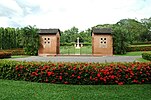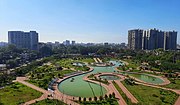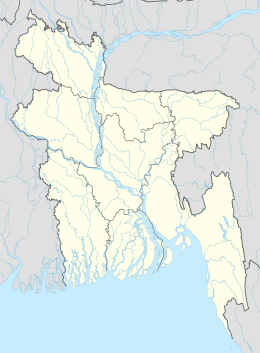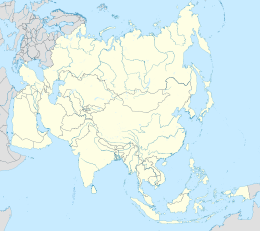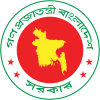Chittagong
Chittagong
চট্টগ্রাম | |
|---|---|
| Chattogram | |
| Nickname(s): | |
| Coordinates:22°20′06″N91°49′57″E/ 22.33500°N 91.83250°E | |
| Country | |
| Division | Chittagong |
| District | Chittagong |
| Establishment | 1340 |
| Granted city status | 1863[3] |
| Government | |
| • Type | Mayor–Council |
| • Body | Chattogram City Corporation |
| •Mayor | Rezaul Karim Chowdhury |
| •Police Commissioner | Md. Saiful Islam |
| Area | |
| •Metropolis | 168.07 km2(64.89 sq mi) |
| • Urban | 272.03 km2(105.03 sq mi) |
| • Metro | 655.74 km2(253.18 sq mi) |
| Elevation | 29 m (95 ft) |
| Population (2024) | |
| •Metropolis | 5,513,609[2] |
| • Density | 32,008/km2(82,900/sq mi) |
| •Urban | 7,000,000 |
| •Metro | 8,254,000 |
| • City rank | 2nd in Bangladesh |
| • Metro rank | 2nd in Bangladesh; 3rd in Bengal Region; |
| Demonym(s) | Chittagonian, Chatgaiya, Sitainga |
| Languages | |
| • Official | Bengali• English |
| Time zone | UTC+6(BST) |
| Postal code | 4000, 4100, 42xx |
| Calling code | +880 31 |
| UN/LOCODE | BD CGP |
| Metro GDP/PPP (2020) | |
| HDI(2019) | 0.654[6] medium |
| Police | Chattogram Metropolitan Police |
| International Airport | Shah Amanat International Airport |
| Metropolitan Planning Authority | Chittagong Development Authority |
| Water Supply and Sewerage Authority | Chattogram WASA |
| Website | ccc.gov.bd |
Chittagong(/ˈtʃɪtəɡɒŋ/CHIT-ə-gong),[7]officiallyChattogram[8](Bengali:চট্টগ্রাম,romanized:Côṭṭôgrām[ˈtʃɔʈːoɡram],Chittagonian:চাটগাঁওromanized:Sāṭgão), is thesecond-largest cityinBangladesh.Home to thePort of Chittagong,it is the busiest port in Bangladesh and theBay of Bengal.[9]It is the administrative seat of an eponymousdivisionanddistrict.The city is located on the banks of theKarnaphuli Riverbetween theChittagong Hill Tractsand the Bay of Bengal. The Greater Chittagong Area had a population of more than 5.2 million in 2022.[10]In 2020, the city area had a population of more than 3.9 million.[11]The city is home to many large local businesses and plays an important role in theBangladeshi economy.
One of the world's oldest ports with a functionalnatural harborfor centuries,[12]Chittagong appeared on ancientGreekandRomanmaps, including onPtolemy's world map.It was located on the southern branch of theSilk Road.In the 9th century, merchants from theAbbasid Caliphateestablished a trading post in Chittagong.[13][14]The port fell to the Muslim conquest of Bengal during the 14th century. It was the site of aroyal mintunder theDelhi Sultanate,Bengal SultanateandMughal Empire.[15]Between the 15th and 17th centuries, Chittagong was also a center of administrative, literary, commercial and maritime activities inArakan,a narrow strip of land along the eastern coast of the Bay of Bengal which was under strong Bengali influence for 350 years. During the 16th century, the port became aPortuguese trading postandJoão de Barrosdescribed it as "the most famous and wealthy city of the Kingdom of Bengal".[16]The Mughal Empire expelled the Portuguese and Arakanese in 1666.
TheNawab of Bengalceded the port to theBritish East India Companyin 1793. ThePort of Chittagongwas re-organized in 1887 and its busiest shipping links were withBritish Burma.In 1928, Chittagong was declared a "Major Port" ofBritish India.DuringWorld War II,Chittagong was a base forAllied Forcesengaged in theBurma Campaign.The port city began to expand and industrialize during the 1940s, particularly after thePartition of British India.The city was the historic terminus of theAssam Bengal RailwayandPakistan Eastern Railway.During theBangladesh Liberation Warin 1971, Chittagong was the site of theBangladeshi declaration of independence.The port city has benefited from the growth ofheavy industry,logistics, and manufacturing in Bangladesh. Trade unionism was strong during the 1990s.
Chittagong accounts for 12% of Bangladesh's GDP, including 40% of industrial output, 80% ofinternational trade,and 50% oftaxrevenue. The port city is home to many of the oldest and largest companies in the country. The Port of Chittagong is one of the busiest ports inSouth Asia.Thelargest baseof theBangladesh Navyis located in Chittagong, along with an air base of theBangladesh Air Force,garrisons of theBangladesh Armyand the main base of theBangladesh Coast Guard.The eastern zone of theBangladesh Railwayis based in Chittagong. TheChittagong Stock Exchangeis one of the twin stock markets of Bangladesh with over 700 listed companies. TheChittagong Tea Auctionis acommodity exchangedealing withBangladeshi tea.TheCEPZandKEPZare key industrial zones with foreign direct investments. The city is served byShah Amanat International Airportfor domestic and external flights.Bangabandhu Sheikh Mujibur Rahman Tunnel,the first and onlyunderwater road tunnelof South Asia, is located in Chittagong. The city is the hometown of prominent economists, a Nobel laureate, scientists, freedom fighters and entrepreneurs. Chittagong has a high degree of religious and ethnic diversity among Bangladeshi cities, despite having a greatMuslimmajority. Minorities includeHindus,Christians,Buddhists,Chakmas,Marmas,Tripuris,Garosand others. The people of Chittagong are generally considered a different ethnic group in contrast to Bengalis.
Etymology
[edit]TheetymologyofChittagongis uncertain.[17]The port city has been known by various names in history, includingChatigaon,Chatigam,Chattagrama,Islamabad,Chattala,ChaityabhumiandPorto Grande De Bengala.[18]
The Bengali word for Chittagong,Chattogram (চট্টগ্রাম),has the suffix "-gram" (গ্রাম) meaning village inStandard Bengali.The earliest records, before Islam reached the region, state that it was a place of chaitya or Buddhist monasteries. The city had a very large Buddhist population before Islam. The city was renamedIslamabad (City of Islam)during the Mughal era. The name continues to be used in the old city. In April 2018, theCabinet Divisionof theGovernment of Bangladeshdecided to change the city's name to Chattogram,[8][19]based on its Bengali spelling and pronunciation; the move was criticized in the Bangladeshi media.[20]
One explanation credits the first Arab traders forshatt ghangh(Arabic:شط غنغ) whereshattmeans "delta" andghanghstood for the Ganges.[17][21][22]TheArakanesechronicle that a king named Tsu-la-taing Tsandaya (Sula Taing Chandra), after conquering Bengal, set up a stone pillar as a trophy/memorial at the place since calledTst-ta-gaungas the limit of conquest.[23]
History
[edit]

Stone Agefossils and tools unearthed in the region indicate that Chittagong has been inhabited sinceNeolithictimes.[24]It is an ancient port city, with a recorded history dating back to the 4th century BC.[25]Its harbour was mentioned inPtolemy's world mapin the 2nd century as one of the most impressive ports in theEast.[12]The region was part of the ancient BengaliSamatataandHarikelakingdoms. TheChandra dynastyonce dominated the area and was followed by theVarman dynastyandDeva dynasty.
Chinese travellerXuanzangdescribed the area as "a sleeping beauty rising from mist and water" in the 7th century.[26]
Arab Muslim traders frequented Chittagong from the 9th century. In 1154,Al-Idrisiwrote of a busy shipping route betweenBasraand Chittagong, connecting it with theAbbasidcapital ofBaghdad.[21]
ManySufimissionaries settled in Chittagong and played an instrumental role in thespread of Islam.[27]
SultanFakhruddin Mubarak ShahofSonargaonconquered Chittagong in 1340,[28]making it a part of Sultanate of Bengal. It was the principal maritime gateway to the kingdom, which was reputed as one of the wealthiest states in theIndian subcontinent.Medieval Chittagong was a hub for maritime trade with China,Sumatra,theMaldives,Sri Lanka,the Middle East, and East Africa. It was notable for its medieval trades in pearls,[29]silk, muslin, rice, bullion, horses, and gunpowder. The port was also a majorshipbuildinghub.
Ibn Battutavisited the port city in 1345.[30]Niccolò de' Conti,from Venice, also visited around the same time as Battuta.[31]Chinese admiralZheng He'streasure fleetanchored in Chittagong during imperial missions to the Sultanate of Bengal.[32][33]
Dhaniya Manikya conquered Chittagong in 1513. Hossain Shah sent his noble commander Gorai Mallik to attack Tripura. Gorai Mallik recaptured the territories lost. But the following year Dhaniya Manikya again conquered Chittagong.[34]
Chittagong featured prominently in the military history of the Bengal Sultanate, including during theReconquest of Arakanand theBengal Sultanate–Kingdom of Mrauk U War of 1512–1516.


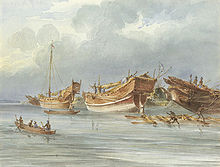

During the 13th and 16th centuries,ArabsandPersiansheavily colonized the port city of Chittagong, initially arriving for trade and to spreadIslam.Most Arab settlers arrived from the trade route betweenIraqand Chittagong and were perhaps the prime reason for the spread of Islam toBangladesh.[13]The first Persian settlers also arrived for trade and religious purposes, with the possible goal ofPersianisationas well. Persians and otherIranic peopleshave deeply affected the history of the Bengal Sultanate, with Persian being one of the main languages of the Muslim state, as well as also influencing the Chittagonian language and writing scripts.[35][36]It has been affirmed that much of the Muslim population in Chittagong are descendants of the Arab and Persian settlers.[37]
Two decades afterVasco Da Gama's landing inCalicut,the Bengal Sultanate permitted the Portuguese settlement in Chittagong to be established in 1528. It became the first European colonial enclave in Bengal. The Bengal Sultanate lost control of Chittagong in 1531 after Arakan declared independence and the established Kingdom of Mrauk U. This altered geopolitical landscape allowed the Portuguese unhindered control of Chittagong for over a century.[38]
Portuguese ships from Goa andMalaccabegan frequenting the port city in the 16th century. Thecartazsystem was introduced and required all ships in the area to purchase naval trading licenses from the Portuguese settlement.[39]Slave tradeand piracy flourished. The nearby island ofSandwipwas conquered in 1602. In 1615, thePortuguese Navydefeated a jointDutch East India Companyand Arakanese fleet near the coast of Chittagong.

In 1666, the Mughal government of Bengal led by viceroyShaista Khanmoved to retake Chittagong from Portuguese and Arakanese control by launching the Mughal conquest of Chittagong. The Mughals attacked the Arakanese from the jungle with a 6,500-strong army, which was further supported by 288 Mughal naval ships blockading the Chittagong harbor.[27]After three days of battle, the Arakanese surrendered. The Mughals expelled the Portuguese from Chittagong. Mughal rule ushered a new era in the history of Chittagong territory to the southern bank of Kashyapnadi (Kaladan River). The port city was renamed Islamabad. The Grand Trunk Road connected it withNorth Indiaand Central Asia. Economic growth increased due to an efficient system of land grants for clearing hinterlands for cultivation. The Mughals also contributed to the architecture of the area, including the building of Fort Ander and many mosques. Chittagong was integrated into the prosperous Bengali economy, which also includedOrissaandBihar.[33][40]Shipbuilding increased dramatically under the Mughal rule, and the Ottoman Sultans had many Ottoman warships built in Chittagong during this period.[41]
In 1685, the British East India Company sent out an expedition under Admiral Nicholson with the instructions to seize and fortify Chittagong on behalf of the English; however, the expedition proved abortive. Two years later, the company's Court of Directors decided to make Chittagong the headquarters of their Bengal trade and sent out a fleet of ten or eleven ships to seize it under Captain Heath. However, after reaching Chittagong in early 1689, the fleet found the city too strongly held and abandoned their attempt at capturing it. The city was possessed by the Nawab of Bengal until 1793 when East India Company took complete control of the former Mughal province of Bengal.[42][43]
TheFirst Anglo-Burmese Warin 1823 threatened the British hold on Chittagong. There were several rebellions against British rule, notably during theIndian rebellion of 1857,when the 2nd, 3rd, and 4th companies of the 34thBengal Infantry Regimentrevolted and released all prisoners from the city's jail. In a backlash, the rebels were suppressed by theSylhet Light Infantry.[21]
Arakanwas annexed in 1829 and incorporated into theBengal Presidency.Agriculturalists from Chittagong played a key role in the development of thericeeconomy in Arakan.[44]The economy of northern Arakan was integrated with the Chittagong economy. During this period,Arakan Divisionbecame one of the top rice exporters in the world.[45][46]Bengalis from Chittagong were vital to the success of Arakan's rice industry.
Railways were introduced in 1865, beginning with theEastern Bengal Railwayconnecting Chittagong toDaccaandCalcutta.Chittagong became the main gateway toEastern Bengal and Assam.[47]In the 1890s, Chittagong became the terminus ofAssam Bengal Railway.The hinterland of Chittagong Port covered theteaandjuteproducing regions of Assam and Bengal, as well asAssam's oil industry.Chittagong was also linked to the crucialoil and gas industry in Burma.Chittagong was a major center of trade withBritish Burma.It hosted many prominent companies of the British Empire.
TheChittagong armoury raidby Bengali revolutionaries in 1930 was a major event in British India's anti-colonial history.
World War II
[edit]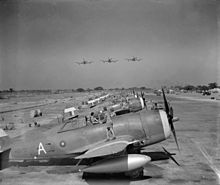
During World War II, Chittagong became a frontline city in theSoutheast Asian Theater.It was a critical air, naval and military base for Allied Forces during theBurma Campaignagainst Japan. TheImperial Japanese Army Air Forcecarried outair raidson Chittagong in April and May 1942, in the run-up to the aborted Japanese invasion of Bengal.[48][49]
After theBattle of Imphal,the tide turned in favor of the Allied Forces. Units of the United States Army Air Forces'4th Combat Cargo Groupwere stationed in Chittagong Airfield in1945.[50]Commonwealth forces included troops from Britain, India, Australia, and New Zealand. The war had major negative impacts on the city, including the growth of refugees and theGreat Famine of 1943.[21]Many wealthy Chittagonians profited from wartime commerce.
715 soldiers are buried at theChittagong War Cemetery,which is maintained by theCommonwealth War Graves Commission.Allied soldiers constitute the bulk of burials in the cemetery. A few Japanese soldiers are also buried. Remembrance Day services are held each year at the cemetery, with diplomats from Commonwealth countries like the UK, Bangladesh, Australia, India and Pakistan, as well as the United States and Japan, usually in attendance.[51]
Modern
[edit]

ThePartition of British Indiain 1947 made Chittagong the chief port ofEast Pakistan.By March 1948, the Chittagong harbour became a bustling port for international shipping.[52]TheChittagong Tea Auctionwas set up in 1949. The port city had branches of theChartered Bank of India, Australia and China,Burmah Oil(known locally asBurmah Eastern), and theJames Finlay shipping business.Wealthy Muslim families from British India and British Burma shifted their corporate headquarters to Chittagong. TheIspahani familyshifted the head office ofM. M. Ispahani Limitedfrom Calcutta to Chittagong.[53]The Ispahanis also relocated the Eastern Federal Insurance Company from Calcutta to Chittagong.[54]The Ispahanis set up the Victory Jute Mills, the Chittagong Jute Manufacturing Company, and the Pahartali Textile Mills.[55]The Africawala brothers set up the first steel re-rolling mills in Chittagong in 1952, which eventually becameBSRM.[56][57]Banks, shipping companies and insurance firms proliferated the city. ManyBritish-owned businesses in East Pakistan were based in Chittagong. Britain's former flag carrierBOACoperated flights to the city. TheAgrabadarea emerged as thecentral business districtin the 1950s and 1960s, with many corporate offices. The Ispahani Building and Jamuna Bhaban are some of the corporate buildings from this period. TheKarnaphuli Paper Millswere built in 1959. The project to build theEastern Refinerywas started in 1963;[58]and was partly funded by the lastShah of Iran.The Agrabad Chamber of Commerce was formed in 1963. It later became the Foreign Investors' Chamber of Commerce and Industry in Bangladesh.[59]The Chittagong Development Authority (CDA) was created by the government to promote urban planning; while wealthy families like the Ispahanis contributed to social welfare by setting up schools and hospitals.[60]
The lawyer and industrialistA K Khan,who set upA K Khan & Companyin the aftermath of World War II, represented Chittagong in the federal cabinet of East and West Pakistan. However, East Pakistanis complained of a lack of investment in Chittagong in comparison toKarachiinWest Pakistan,even though East Pakistan generated more exports and had a larger population. TheAwami Leaguedemanded that the country's naval headquarters be shifted from Karachi to Chittagong.[61]
During theBangladesh Liberation Warin 1971, which was waged under the leadership ofSheikh Mujibur Rahman,Chittagong witnessed heavy fighting between rebel Bengali military regiments and the Pakistan Army. It coveredSector 1in theMukti Bahinichain of command. MajorZiaur Rahmanwas the sector commander. The Bangladeshi Declaration of Independence was broadcast fromKalurghatRadio Station and transmitted internationally through foreign ships in Chittagong Port.[62]Ziaur Rahman andM A Hannanannounced the independence declaration from Chittagong. A K Khan drafted the English version of Zia's broadcast.[63]These radio broadcasts began the journey ofSwadhin Bangla Betar Kendra,which contributed heavily towards the Liberation. The Pakistani military, and supportingRazakarmilitias, carried out widespread atrocities against civilians in the city. Mukti Bahini naval commandos drowned several Pakistani warships during Operation Jackpot in August 1971.[64]In December 1971, theBangladesh Air Forceand theIndian Air Forcecarried out the heavy bombing of facilities occupied by the Pakistani military. Anaval blockadewas also enforced.[65]
After the war, theSoviet Unionoffer to clear mines in Chittagong Port at free of cost, whileSwedenoffered to clear mines inMonglaport.[66]22 vessels of theSoviet Pacific Fleetsailed fromVladivostokto Chittagong in May 1972.[67]The process of clearing mines in the dense water harbor took nearly a year and claimed the life of Soviet marine Yuri V Redkin.[68][69]Chittagong soon regained its status as a major port, with cargo tonnage surpassing pre-war levels in 1973. In the immediate aftermath of 1971, many industries were nationalized. But in Chittagong, factories and business properties were given back to their private owners. The Ispahani family had to write only one letter in order to get back all their properties from the Awami League government of Prime Minister Sheikh Mujibur Rahman.[70]
Infree marketreforms launched by President Ziaur Rahman in the late 1970s, the city became home to the firstexport processing zonesin Bangladesh. Zia wasassassinatedduring an attempted military coup in Chittagong in 1981. The1991 Bangladesh cycloneinflicted heavy damage on the city. The Japanese government financed the construction of several heavy industries and an international airport in the 1980s and 1990s. Bangladeshiprivate sectorinvestments increased since 1991, especially with the formation of the Chittagong Stock Exchange in 1995. A new airport opened in 2000. The port city has been the pivot of Bangladesh'semerging economyin recent years, with the country's rising GDP growth rate. Chittagong has seen several infrastructure projects taken up by the government of Prime MinisterSheikh Hasina,including the Chittagong Elevated Expressway, the first underwater tunnel in South Asia, the expansion of its port, and new parks, power plants and flyovers.[71][72]Hasina's government has planned several new economic zones around the city, including the flagship Bangabandhu Sheikh Mujibur Rahman Industrial City of theBangladesh Economic Zones Authority.[73]
Geography
[edit]Topography
[edit]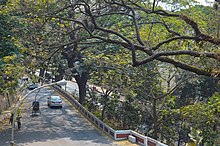
Chittagong lies at22°20′06″N91°49′57″E/ 22.33500°N 91.83250°E.It straddles the coastal foothills of the Chittagong Hill Tracts in southeastern Bangladesh. The Karnaphuli River runs along the southern banks of the city, including its central business district. The river enters the Bay of Bengal in anestuarylocated 12 kilometres (7.5 mi) west of downtown Chittagong. Mount Sitakunda is the highest peak in Chittagong District, with an elevation of 351 metres (1,152 ft).[74]Within the city itself, the highest peak is Batali Hill at 85.3 metres (280 ft). Chittagong has many lakes that were created under the Mughal rule. In 1924, an engineering team of the Assam Bengal Railway established theFoy's Lake.[74]
Major sediment outflows from the Ganges and Brahmaputra rivers form tidal flats around the city.[75]
Ecological hinterland
[edit]The Chittagong Division is known for its richbiodiversity.Over 2000 of Bangladesh's 6000 flowering plants grow in the region.[76]Its hills and jungles are laden withwaterfalls,fast flowing river streams and elephant reserves.St. Martin's Island,within the Chittagong Division, is the onlycoral islandin the country. The fishing port ofCox's Bazaris home to one of the world's longest natural beaches. In the east, there are the three hill districts ofBandarban,Rangamati,andKhagrachari,home to thehighest mountains in Bangladesh.The region has numerous protected areas, including theTeknaf Game Reserveand theSitakunda Botanical Garden and Eco Park.[77]
Patengabeach in the main seafront of Chittagong, located 14 kilometres (8.7 mi) west of the city.
Climate
[edit]Under theKöppen climate classification,Chittagong has atropical monsoon climate(Am).[78]
Chittagong is vulnerable toNorth Indian Ocean tropical cyclones.The deadliest tropical cyclone to strike Chittagong was the1991 Bangladesh cyclone,which killed 138,000 people and left as many as 10 million homeless.[79]
| Month | Jan | Feb | Mar | Apr | May | Jun | Jul | Aug | Sep | Oct | Nov | Dec | Year |
|---|---|---|---|---|---|---|---|---|---|---|---|---|---|
| Record high °C (°F) | 33.4 (92.1) |
36.0 (96.8) |
37.2 (99.0) |
39.6 (103.3) |
39.5 (103.1) |
37.7 (99.9) |
34.4 (93.9) |
33.9 (93.0) |
36.3 (97.3) |
34.4 (93.9) |
35.5 (95.9) |
32.5 (90.5) |
39.6 (103.3) |
| Mean daily maximum °C (°F) | 26.0 (78.8) |
28.3 (82.9) |
30.8 (87.4) |
31.9 (89.4) |
32.4 (90.3) |
31.7 (89.1) |
31.0 (87.8) |
31.4 (88.5) |
31.8 (89.2) |
31.7 (89.1) |
30.0 (86.0) |
27.2 (81.0) |
30.4 (86.7) |
| Daily mean °C (°F) | 19.8 (67.6) |
22.3 (72.1) |
25.7 (78.3) |
27.9 (82.2) |
28.6 (83.5) |
28.4 (83.1) |
27.9 (82.2) |
28.1 (82.6) |
28.3 (82.9) |
27.7 (81.9) |
24.9 (76.8) |
21.2 (70.2) |
25.9 (78.6) |
| Mean daily minimum °C (°F) | 14.0 (57.2) |
16.3 (61.3) |
20.5 (68.9) |
23.6 (74.5) |
24.9 (76.8) |
25.4 (77.7) |
25.2 (77.4) |
25.3 (77.5) |
25.2 (77.4) |
24.1 (75.4) |
20.3 (68.5) |
15.8 (60.4) |
21.7 (71.1) |
| Record low °C (°F) | 7.7 (45.9) |
10.6 (51.1) |
15.0 (59.0) |
18.0 (64.4) |
18.0 (64.4) |
20.5 (68.9) |
22.5 (72.5) |
21.0 (69.8) |
21.0 (69.8) |
19.6 (67.3) |
11.0 (51.8) |
9.9 (49.8) |
7.7 (45.9) |
| Averageprecipitationmm (inches) | 7.3 (0.29) |
25.0 (0.98) |
55.5 (2.19) |
136.4 (5.37) |
314.0 (12.36) |
591.3 (23.28) |
735.6 (28.96) |
513.9 (20.23) |
239.3 (9.42) |
197.8 (7.79) |
59.5 (2.34) |
14.1 (0.56) |
2,889.7 (113.77) |
| Average rainy days | 1 | 2 | 4 | 8 | 13 | 16 | 19 | 17 | 13 | 7 | 3 | 1 | 104 |
| Averagerelative humidity(%) | 73 | 70 | 74 | 77 | 79 | 83 | 85 | 85 | 83 | 81 | 78 | 75 | 79 |
| Mean monthlysunshine hours | 264.1 | 244.3 | 276.4 | 242.7 | 227.2 | 116.7 | 105.1 | 124.4 | 166.7 | 218.2 | 241.3 | 245.5 | 2,472.6 |
| Source 1:Bangladesh Meteorological Department[80][81][82] | |||||||||||||
| Source 2: Sistema de Classificación Bioclimática Mundial (extremes),[83]Deutscher Wetterdienst(sun, 1961–1990)[84][a] | |||||||||||||
Government
[edit]
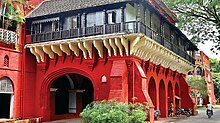

TheChittagong City Corporation(CCC) is responsible for governing municipal areas in the Chittagong Metropolitan Area. It is headed by the mayor of Chittagong. The mayor and ward councillors are elected every five years. The mayor is Rezaul Karim Chowdhury, as of August 2023.[85]The city corporation's mandate is limited to basic civic services, however, the CCC is credited for keeping Chittagong one of the cleaner and most eco-friendly cities in Bangladesh.[86][87]Its principal sources of revenue are municipal taxes and conservancy charges.[21]TheChittagong Development Authorityis responsible for implementing the city's urban planning.
Thedeputy commissioneranddistrict magistrateare the chiefs of local administration as part of the Government of Bangladesh. Law enforcement is provided by theChittagong Metropolitan Policeand theRapid Action Battalion-7. The district and sessions judges are the heads of the localjudiciaryon behalf of theSupreme Court of Bangladesh.[21]The Divisional Special Judge's Court is located in the colonial-era Chittagong Court Building.
Military
[edit]Chittagong is a strategically important military port on the Bay of Bengal. TheChittagong Naval Areais the principal base of the Bangladesh Navy and the home port of mostBangladeshi warships.[88]TheBangladesh Naval Academyand the navy's elite special force-Special Warfare Diving and Salvage(SWADS) are also based in the city.[89]TheBangladesh Army's 24th Infantry Division is based inChittagong Cantonment,and the Bangladesh Air Force maintains the BAF Zahurul Haq Air Base in Chittagong.[90]The city is also home to theBangladesh Military Academy,the premier training institute for the country'sarmed forces.
Diplomatic representation
[edit]In the 1860s, the American consulate-general in theBengal Presidencyincluded a consular agency in Chittagong.[91]Today, Chittagong hosts an assistant high commission of India and a consulate general of Russia. The city also hashonorary consulatesof Turkey, Japan, Germany, South Korea, Malaysia, Italy, and the Philippines.[92][93][94][95][96][97][98]
Economy
[edit]| Top publicly traded companies in Chittagong, in 2014[99] | |||||
| Jamuna Oil Company | |||||
| BSRM | |||||
| Padma Oil Company | |||||
| PHP | |||||
| Meghna Petroleum | |||||
| GPH Ispat | |||||
| Aramit Cement | |||||
| Western Marine Shipyard | |||||
| RSRM | |||||
| Hakkani Pulp & Paper | |||||
| Source: Chittagong Stock Exchange | |||||
A substantial share of Bangladesh's national GDP is attributed to Chittagong. The port city contributes 12%[5]of the nation's economy. Chittagong generates for 40% of Bangladesh'sindustrial output,80% of itsinternational tradeand 50% of its governmentalrevenue.[100][101]TheChittagong Stock Exchangehas more than 700 listed companies, with amarket capitalisationof US$32 billion in June 2015.[99]The city is home to many of the country's oldest and largest corporations. The Port of Chittagong handled US$60 billion in annual trade in 2011, ranking 3rd in South Asia after thePort of Mumbaiand thePort of Colombo.[9][101]The port is part of the MaritimeSilk Roadthat runs from the Chinese coast via theSuez Canalto the Mediterranean and on to the Upper Adriatic region ofTriestewith rail connections toCentralandEastern Europe.[102][103][104]




TheAgrabadarea is the main central business district of the city. Major Bangladeshiconglomeratesheadquartered in Chittagong includeM. M. Ispahani Limited,BSRM,A K Khan & Company,PHP Group,James Finlay Bangladesh,theHabib Group,theS. Alam Group of Industries,Seamark Group,KDS Groupand theT. K. Group of Industries.Majorstate-ownedfirms headquartered there include Pragati Industries, the Jamuna Oil Company, theBangladesh Shipping Corporation,and the Padma Oil Company. TheChittagong Export Processing Zonewas ranked by the UK-based magazine,Foreign Direct Investment,as one of the leadingspecial economic zonesin the world, in 2010.[105]Other SEZs include theKarnaphuli Export Processing Zoneand Korean EPZ. The city's key industrial sectors includepetroleum,steel,shipbuilding,chemicals,pharmaceuticals,textiles,jute,leather goods,vegetable oil refineries, glass manufacturing,electronicsandmotor vehicles.The Chittagong Tea Auction sets the price of Bangladesh Tea. The Eastern Refinery is Bangladesh's largestoil refinery.GlaxoSmithKlinehas had operations in Chittagong since 1967.[106]Western Marine Shipyard is a leading Bangladeshi shipbuilder and exporter of medium-sized ocean-going vessels. In 2011–12, Chittagong exported approximately US$4.5 billion inready-made garments.[107]TheKarnaphuli Paper Millswere established in 1953.
International banks operating in Chittagong includeHSBC,Standard CharteredandCitibank NA. Chittagong is often called Bangladesh's commercial capital due to its diversified industrial base and seaport. The port city has ambitions to develop as a global financial center and regionaltransshipmenthub, given its proximity toNorth East India,Burma,Nepal,Bhutanand Southwest China.[108][109]
By 2024, the Chittagong-basedS Alam Groupemerged as one of Bangladesh's most powerful conglomerates, with interests in energy,commodities,infrastructure, economic zones, healthcare, textiles andfintech.[110]S Alam's projects include a $640 million steel plant, a $2.6 billion power plant and a $3 billion renewable energy plant.[110]It is investing 580 billionBDTin two industrial zones in Chittagong.[111]S Alam also has substantial offshore assets, including a billion dollars worth of real estate inSingapore.[112]Its portfolio in Singapore includes the city-state's Hilton Garden Inn Serangoon hotel.[113]The S Alam Group enjoys close ties with the ruling Awami League party in Bangladesh. The group has been subjected to intense media scrutiny.
Financial and commodity markets
[edit]Trade associations
[edit]Industrial areas
[edit]- Chittagong Export Processing Zone
- Karnaphuli Export Processing Zone
- Bangabandhu Sheikh Mujib Shilpa Nagar, Mirsarai
- Korean Export Processing Zone, Anwara
- Chinese Economic and Industrial Zone, Anwara
- Maheshkhali Economic Zone, Matarbari
- Kalurghat Heavy Industrial Area
Architecture
[edit]
The Anderkilla Shahi Jame Mosque is a well-knownMughalproperty in Chittagong. Anderkilla means "inner fort".[114]The mosque was built in 1667 by Umed Khan, the son ofShaista Khan,after theMughal conquest of Chittagong.The mosque is the only surviving part of a hilltop Mughal fort. A surviving remnant of the 17th centuryPortuguese presenceis Darul Adalat in the premises ofGovernment Hazi Mohammad Mohsin College, Chittagong.The Kadam Mubarak Mosque in Jamal Khan was built in 1723 by afaujdarduring the reign of theNawabs of Bengal.[115]DuringBritish rule,colonial officials lived in hilltop bungalows, which would feature a spaciousbalconyorverandah,chimneys, fireplaces and big gardens. The Firingi Bazaar has many colonial houses which belonged to rich local residents. The well-known buildings from the British colonial period include the Battali Railway Station,Central Railway Building,Chittagong Circuit HouseandChittagong Court Building.
The old Circuit House was originally built in the style ofTudor revival architecture.The Chittagong Court Building exhibits influence ofneoclassical architecturefrom the late 19th century. JM Sen Hall was a town hall built in 1920.[116]One of the grand old mansions of Chittagong is the PK Sen Bhaban.[117][118]The First Karnaphuli Bridge, which was a steel bridge, was built in 1930.[119]TheKalurghat Bridgewas completed in 1931.[120]Stripped Classicismand elements ofart decocan be seen inAgrabad.M. M. Ispahani Limitedrelocated its head office to Chittagong from Calcutta after thepartition of India;[121]the Ispahani building in Agrabad was influenced by the art deco style. Another building with 1930s classical and art deco elements is the headquarters of theJamuna Oil Company.The building has a dome and modernist columns inspired by the style of the 1930s and 1940s.
Culture
[edit]

An inhabitant of Chittagong is calledChittagonianin English.[122]For centuries, the port city has been amelting potfor people from all over the world. Its historic trade networks have left a lasting impact on its language, culture, and cuisine. TheChittagonian language,although identified as a nonstandard dialect of Bengali, is considered to be a separate language by many linguists. The Chittagonian language has many Arabic, Persian, English and Portuguese loanwords.[21]The popular traditional feast ofMezbanfeatures the serving of hot beef dish with white rice.[122]Another dish namedkala-bhunaof Chittagong, made with traditional spices, mustard oil, and beef through a special cooking style, is also renowned all over Bangladesh. The cultivation of pinkpearlsis a historic activity in Chittagong. Its Mughal-era name,Islamabad(City of Islam), continues to be used in the old city. The name was given due to the port city's history as a gateway for early Islamic missionaries in Bengal. Notable Islamic architecture in Chittagong can be seen in the historic Bengal Sultanate-era Hammadyar Mosque and the Mughal Fort of Anderkilla. Chittagong is known as theLand of the Twelve Saints[123]due to the prevalence of major Sufi Muslim shrines in the district. Historically,Sufismplayed an important role in the spread of Islam in the region. Prominentdargahsinclude the mausoleums of Shah Amanat, Badr Auliya, Miskin Shah, Garibullah Shah and the shrine ofBayazid Bastamiamong many others. The Bastami shrine hosts a pond ofblack softshell turtles,a critically endangered species of freshwater turtle.

During the medieval period, many poets thrived in the region when it was part of the Bengal Sultanate and the Kingdom of Mrauk U. Under the patronage of SultanAlauddin Husain Shah's governor in Chittagong, Kabindra Parameshvar wrote his Pandabbijay, a Bengali adaptation of theMahabharata.[124]Daulat Qazilived in the region during the 17th-century reign of the Kingdom of Mrauk U. Chittagong is home to several importantHindutemples, including theChandranath Templeon the outskirts of the city, which is dedicated to the Hindu goddessSita.[125]The city also hosts the country's largestBuddhistmonastery and council of monks. TheRoman Catholic Diocese of Chittagongis the oldest catholic mission in Bengal.[126]
Major cultural organizations in the city include theTheatre Institute Chittagongand theChittagong Performing Arts Academy.The city has a vibrantcontemporary artscene.
Being home to the pioneering rock bands in the country likeSouls[127]andLRB,[128]Chittagong is regarded as the "birthplace ofBangladeshi rock music".[129][130][131]
Demographics
[edit]

| Year | Pop. | ±% |
|---|---|---|
| 1931 | 53,156 | — |
| 1941 | 92,301 | +73.6% |
| 1991 | 1,392,958 | +1409.1% |
| 2001 | 2,023,489 | +45.3% |
| 2011 | 2,582,401 | +27.6% |
| 2022 | 3,227,246 | +25.0% |
| sources:citypopulation.de | ||
At the 2011 Census, Chittagong had a population of more than 2.5 million,[132]and its Metropolitan Area had a population of 4,009,423.[133]By gender, the population was 54.36% male and 45.64% female, and the literacy rate in the city was approximately 72 percent, in 2020.
Muslims,numbering approximately 3.44 million, form the overwhelming majority of the city's population, with the rest being predominantly Hindus, numbering approximately 480,000, and the remaining 2% belonging to other religions, such as Buddhism and Christianity.[21]
Language in Chittagong District (1931)[relevant?][135]
Chittagong was amelting potof ethnicities during theBengal SultanateandMughal Bengalperiods. Muslim immigration started as early as the seventh century, and significant Muslim settlements occurred during the medieval period. Muslim traders, rulers, and preachers from Persia and Arabia were the early Muslim settlers, and their descendants are the majority of the current Muslim population of the city. The city has a relatively wealthy and economically influentialShia Muslimcommunity, includingIsmailisandTwelverShias. The city also has many ethnic minorities, especially members ofindigenous groupsfrom the frontier hills of Chittagong Division, includingChakmas,RakhinesandTripuris;as well asRohingyarefugees. The Bengali-speakingTheravada Buddhistsof the area, known asBaruas,are one of the oldest communities in Chittagong and one of the last remnants of Buddhism in Bangladesh.[136][137][138]Descendants of Portuguese settlers, often known asFiringis,also live in Chittagong, as well asCatholics,who largely live in the old Portuguese enclave of Paterghatta.[21]There is also a small Urdu-speakingBihari communityliving in the ethnic enclave known asBihari Colony.[139][140] Like other major urban centres in South Asia, Chittagong has experienced steady growth in itsinformal settlementsas a result of the increasing economic activities in the city and emigration from rural areas. According to a poverty reduction publication of theInternational Monetary Fund,there were 1,814slumswithin the city corporation area, inhabited by about 1.8 million slum dwellers, the second highest in the country after the capital,Dhaka.[141]The slum dwellers often face eviction by the local authorities, charging them with illegal abode on government lands.[142][143]In the early 1990s, Chittagong had a population of just over 1.5 million, of which there were an estimated 66,676squattersliving in 69 areas.[144]
Media and communications
[edit]Various newspapers, including daily, opposition, and business newspapers, are based in Chittagong. Daily newspapers includeDainik Azadi,[145]Peoples View,[146]The Daily Suprobhat Bangladesh,Daily Purbokone,Life, Karnafuli, Jyoti, Rashtrobarta and Azan. Furthermore, there are several weekly and monthly newspapers. These includeweekliessuch as Chattala, Jyoti, Sultan, Chattagram Darpan, and the monthlies such as Sanshodhani, Purobi, Mukulika, and Simanto. The only press council in Chittagong is the Chittagong Press Club. Government-ownedBangladesh Television,with itsChittagongstation, andBangladesh Betarhave transmission centres in the city. A local online news & media Channel based on the Chittagonian language was launched in 2016 calledCplusTv,[147]gained vast popularity. The channel is YouTube- and social network-based, and it reached the 1 million followers milestone on Facebook.[citation needed]
Chittagong has been featured in all aspects of Bangladeshi popular culture, including television, movies, journals, music, and books. Nearly all televisions and radios in Bangladesh have coverage in Chittagong. RenownedBollywoodfilm directorAshutosh Gowarikerdirected a movie based on the 1930s Chittagong Uprising, Movie's name isKhelein Hum Jee Jaan Sey[148]in whichAbhishek Bachchanplayed the lead role.[149][150]
Utilities
[edit]The southern zone of theBangladesh Power Development Boardis responsible for supplying electricity to city dwellers.[151][152]The fire services are provided by theBangladesh Fire Service & Civil Defencedepartment, under the Ministry of Home Affairs.[153] Total Electricity Consumption is approximately 1000 megawatts in the city proper. But in the whole Chittagong urban and city proper, it will be 1300 megawatts plus-minus. Ss power plant will be in production next year and its production power is 1320 megawatts And it creates Chittagong City as the energy production hub of Bangladesh
The water supply and sewage systems are managed by the Chittagong Water Supply and Sewerage Authority (Chittagong WASA).[154][155]Water is primarily drawn from Karnaphuli River and then purified in the Mohra Purification Plant.[156]
Chittagong has extensiveGSMandCDMAcoverage, served by all the major mobile operators of the country, includingGrameenphone,Banglalink,Citycell,Robi,TeleTalkandAirtel Bangladesh.However, landline telephone services are provided through the state-ownedBangladesh Telegraph and Telephone Board(BTTB), as well as some private operators. BTTB also provides broadband Internet services, along with some privateISPs,including the4Gservice providersBanglalion[157]and Qubee.[158]
Education and research
[edit]

The education system of Chittagong is similar to that ofrest of Bangladesh,with four main forms of schooling. The general education system, conveyed in both Bangla and English versions, follows the curriculum prepared by theNational Curriculum and Textbook Board,part of theMinistry of Education.[159]Students are required to take two major board examinations:theSecondary School Certificate(SSC) and theHigher Secondary School Certificate(HSC) before moving onto higher education. TheBoard of Intermediate and Secondary Education, Chittagongis responsible for administering SSC and HSC examinations within the city.[160][161]TheMadrasaheducation system is primarily based on Islamic studies, though other subjects are also taught. Students are prepared according to the Dakhil and Alim examinations, which are controlled by theBangladesh Madrasah Education Boardand are equivalent to SSC and HSC examinations of the general education system respectively.[162]There are also several private schools in the city, usually referred to asEnglish medium schools,[159]which follow theGeneral Certificate of Education.
TheBritish Councilsupervises theO LevelsandA levelsexaminations, conducted twice a year, through theCambridge InternationalandEdexcelexamination boards.[163][164]The Technical and Vocational education system is governed by the Directorate of Technical Education (DTE) and follow the curriculum prepared byBangladesh Technical Education Board(BTEB).[165][166]Chittagong College,established in 1869, is the earliest modern institution for higher education in the city.[167]Chittagong Veterinary and Animal Sciences Universityis the only public university located in Chittagong city.Chittagong Medical Collegeis the only government medical college in Chittagong.
University of Chittagongis located 22 kilometres (14 miles) north andChittagong University of Engineering and Technologyis located 25 kilometres (16 miles) north of the Chittagong city. The University of Chittagong, established in 1966 is one of the largest universities in Bangladesh. Chittagong University of Engineering and Technology, established in 1968, is one of the five public engineering universities in Bangladesh and the only engineering university in the Chittagong Division.
The city also hosts several other private universities and medical colleges. TheBGC Trust University Bangladesh,Chittagong Independent University (CIU),Asian University for Women,Port City International University,East Delta University,International Islamic University,Premier University,Southern University,University of Information Technology and Sciencesand theUniversity of Science & Technology Chittagongare among them. Chittagong has public, denominational, and independent schools. Public schools, including pre-schools, primary and secondary schools, and special schools are administered by the Ministry of Education andChittagong Education Board.Chittagong has governmental and non-governmental primary and higher secondary schools, international schools, and English medium schools, such asCDA Public School and College.Southeast Public School & CollegeJamia Ahmadiyya Sunnia Kamil Madrasais also a famousIslamic Universitywhich situated in Chittagong.
Research institutes
[edit]- Bangladesh Forest Research Institute
- Bangladesh Institute of Tropical and Infectious Diseases
- Bangladesh Tea Board
Health
[edit]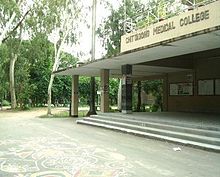
TheChittagong Medical College Hospitalis the largest state-owned hospital in Chittagong. TheChittagong General Hospital,established in 1901, is the oldest hospital in the city.[168]The Bangladesh Institute of Tropical and Infectious Diseases (BITID) is based the city. Other government-run medical centers in the city include the Family Welfare Centre, TB Hospital, Infectious Disease Hospital, Diabetic Hospital, Mother and Children Hospital, and the Police Hospital. Among the city's private hospitals are theBangabandhu Memorial Hospital(BBMH), Chittagong Metropolitan Hospital, Chevron Clinic, Surgiscope Hospital, CSCR, Centre Point Hospital, Park View Hospital, Max Hospital & diagnosis, Imperial Hospital LTD., Evercare Hospital Ltd., National Hospital and Mount Hospital Ltd.[169][170][171]

Private Medical Colleges:
- University of Science & Technology Chittagong
- BGC TRUST Medical College Chittagong
- Chittagong Ma o Shishu Hospital
- Southern Medical College
- Marine City Medical College
- Army Medical College
- Poly Clinic
- CSCR Hospital
Transport
[edit]Transport in Chittagong is similar to that of the capital, Dhaka. large avenues and roads are present throughout the metropolis. There are various bus systems and taxi services, as well as smaller 'baby' or 'CNG' taxis, which are tricycle-structured motor vehicles. Foreign and localridesharing companieslikeUberandPathaoare operating in the city.[172]There are also traditional manual rickshaws, which are very common.
Road
[edit]As the population has risen extensively, the Chittagong Development Authority (CDA) has undertaken some transportation initiatives aimed at easing the traffic congestion in Chittagong. Under this plan, the CDA, along with the Chittagong City Corporation, has constructed some flyovers and expanded the existing roads within the city. There are also some other major expressways and flyovers under construction, most notably the Chittagong City Outer Ring Road, which runs along the coast of Chittagong City. Thisring roadincludes a marine drive along with fivefeeder roadsand is also meant to strengthen the embankment of the coast.[173][174][need quotation to verify][175][176][177]The authority has also began the construction of a 9.3 kilometres (5.8 mi)underwater expressway tunnelthrough the Karnaphuli river to ensure better connectivity between the northern and southern parts of Chittagong. This tunnel will be the first of its kind inSouth Asia.[178][179][180]
TheN1(Dhaka-Chittagong Highway), a major arterial national highway, is the only way to access the city by motor vehicle from most other parts of the country. It is considered a crowded and dangerous highway. This highway is also part ofAH41route of theAsian Highway Network.It has been upgraded to 4 lanes.[181]TheN106(Chittagong-Rangamati Highway) is another major national highway that connects the Chittagong Hill Tracts with theOxygen Square.
Rail
[edit]Chittagong can also be accessed by rail. It has a station on themetre gauge,the eastern section of the Bangladesh Railway, whose headquarters are also located within the city. There are two main railway stations, on Station Road and in thePahartali Thana.Trains to Dhaka,Sylhet,Comilla,and Bhairab are available from Chittagong. TheChittagong Circular Railwaywas introduced in 2013 to ease traffic congestion and to ensure better public transport service for commuters within the city. The railway includes high-speedDEMUtrains with a carrying capacity of 300 passengers. These DEMU trains also travel on the Chittagong-Laksham route which connects the city with Comilla.[182][183]
Air
[edit]
TheShah Amanat International Airport(IATA:CGP,ICAO:VGEG), located at South Patenga, serves as Chittagong's only airport. It is the second busiest airport in Bangladesh. The airport is capable of annually handling 1.5 million passengers and 6,000 tonnes of cargo.[184]Known asChittagong Airfieldduring World War II, the airport was used as a supply point by the United States Army Air Forces'Tenth Air Forceduring theBurma Campaign 1944–45.[50]It officially became a Bangladeshi airport in 1972 after Bangladesh's liberation war.[185]International services fly to major cities of theArabian Peninsulaas well as to Indian city ofKolkata.[186]At present, Middle Eastern airlines likeAir Arabia,Flydubai,Jazeera Airways,Oman AirandSalamAiroperate flights from the city to these destinations along withairlines of Bangladesh.[186]All Bangladeshi airlines operate regular domestic flights to Dhaka. The airport was formerly known asMA HannanInternational Airport but was renamed after a famous Sufi saintShah Amanaton 2 April 2005 by the Government.[187]
Sports
[edit]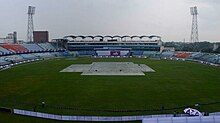
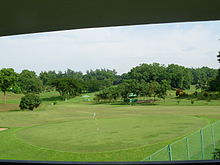
Chittagong has produced numerous cricketers, footballers, and athletes, who have performed at the national level.Tamim Iqbal,Akram Khan,Minhajul Abedin,Aftab Ahmed,Nafees Iqbal,Nazimuddin,Faisal Hossain,Tareq Aziz,Mominul Haque,Nayeem Hasan,Mamunul Islam,Ashish Bhadra,Shahidul Alam Sohelare some of the most prominent figures among them.Cricketis the most popular sport in Chittagong, whilefootball,tennis andkabaddiare also popular. Several stadiums are located in Chittagong with the main one being the multipurposeMA Aziz Stadium,which has aseating capacityof 20,000 and hosts football matches in addition to cricket.[188]MA Aziz Stadium was the stadium where Bangladesh achieved its first-everTest cricketvictory, against Zimbabwe in 2005.[189]The stadium now focuses only on football, and is currently the main football venue of the city.Zohur Ahmed Chowdhury Stadium,is currently the main cricket venue of the city, which was awarded Test status in 2006, hosting both domestic and international cricket matches. The city hosted two group matches of the2011 ICC Cricket World Cup,both taking place in Zohur Ahmed Chowdhury Stadium.[190]It also co-hosted2014 ICC World Twenty20along with Dhaka and Sylhet, Zohur Ahmed Chowdhury Stadium hosted 15 group stage matches. Other stadiums in Chittagong include the Women's Complex Ground. Major sporting clubs such as,Mohammedan Sporting ClubandAbahani Chittagongare also located in the city. Chittagong is also home to theBangladesh Premier Leaguefranchise, theChattogram Challengers.
Teams
[edit]- Chattogram Challengers–BPL(Cricket)
- Chittagong Abahani Limited–BPL(Football)
- Acme Chattogram–HCT(Field hockey)
Twin towns – sister cities
[edit]See also
[edit]Notes
[edit]Explanatory notes
[edit]- ^Station ID for Chittagong (Patenga) is 41978Use this station ID to locate the sunshine duration
Citations
[edit]- ^"Protect the Queen of the East".The Daily Star.10 July 2017.Retrieved3 September2021.
- ^"Chittagong Population 2024".Retrieved14 May2024.
- ^"History of Chittagong City Corporation".Chittagong City Corporation.Archived fromthe originalon 13 August 2013.Retrieved26 May2013.
- ^"Area, Population and Literacy Rate by Paurashava −2001"(PDF).Bangladesh Bureau of Statistics. Archived fromthe original(PDF)on 10 June 2007.Retrieved18 September2009.
- ^ab"Economics Landscape of Chittagong".chittagongchamber.com.Chittagong Chamber.Retrieved16 October2019.
- ^"Sub-national HDI – Area Database – Global Data Lab".hdi.globaldatalab.org.Retrieved11 July2021.
- ^"Definition of Chittagong".Dictionary.com.Retrieved23 February2022.
- ^ab"Mixed reactions as govt changes English spellings of 5 district names".Dhaka Tribune.2 April 2018.
- ^ab"Pangaon container terminal to get a boost".The Daily Star.3 January 2016.
- ^"Chittagong · Population".population.city.Retrieved30 April2022.
- ^"Chattogram, Bangladesh Population (2023) – Population Stat".populationstat.com.Retrieved11 March2023.
- ^abRing, Trudy; Watson, Noelle; Schellinger, Paul (12 November 2012).Asia and Oceania: International Dictionary of Historic Places.Routledge.ISBN978-1-136-63979-1.
- ^ab"Arabs, The".Banglapedia.Retrieved23 February2022.
- ^Islam, Shariful; Hoque, Muhammad Manirul."Unpublished Umayyad and Abbasid Silver Coins in the Bangladesh National Museum"(PDF).Journal of the Asiatic Society of Bangladesh (Hum.).62(2): 205–231. Archived fromthe original(PDF)on 9 October 2022.Retrieved9 March2022.
- ^"Mint Towns".Banglapedia.5 August 2021.Retrieved16 March2022.
- ^"Chittagong | History, Population, & Facts".Encyclopædia Britannica.Retrieved23 February2022.
- ^abO'Malley, L.S.S. (1908).Chittagong.Eastern Bengal District Gazetteers. Vol. 11A. Calcutta: The Bengal Secretariat Book Depot. p. 1.Retrieved8 August2015.
- ^"Bangladesh changes English spellings of five districts".bdnews24.com.
- ^"Experts warn of trade hits from renaming Chittagong".The Financial Express.Archived fromthe originalon 30 November 2021.Retrieved21 March2019.
- ^Chowdhury, Umran (5 April 2018)."From a commercial capital to a village".Dhaka Tribune(Opinion).
- ^abcdefghiOsmany, Shireen Hasan (2012)."Chittagong City".InIslam, Sirajul;Jamal, Ahmed A. (eds.).Banglapedia: National Encyclopedia of Bangladesh(Second ed.).Asiatic Society of Bangladesh.
- ^Bernoulli, Jean; Rennell, James; Anquetil-Duperron, M.; Tieffenthaller, Joseph (1786).Description historique et géographique de l'Inde(in French). Vol. 2. Berlin: C. S. Spener. p. 408.Retrieved8 August2015.
- ^Quanungo, Suniti Bhushan (1988).A History of Chittagong.Vol. 1. Chittagong: Dipanka Quanungol Billan Printers. p. 17.
- ^Khan, M. Morshed (1994).Bangladesh Towards 21st Century.Ministry of Information.OCLC34115814.
- ^"Custom House Chittagong".Archived fromthe originalon 9 November 2015.
- ^"Past of Ctg holds hope for economy".The Daily Star.Archived fromthe originalon 13 April 2014.Retrieved29 August2013.
- ^abTrudy, Ring; M. Salkin, Robert; La Boda, Sharon; Edited by Trudy Ring (1996). International dictionary of historic places. Chicago: Fitzroy Dearborn Publishers.ISBN1-884964-04-4.Retrieved 21 June 2015.
- ^"District LGED".lged.gov.bd.Archived fromthe originalon 3 November 2014.Retrieved16 November2013.
- ^Donkin, R. A. (1998).Beyond Price.American Philosophical Society.ISBN9780871692245.
- ^Dunn, Ross E. (1986).The Adventures of Ibn Battuta, a Muslim Traveler of the Fourteenth Century.University of California Press.ISBN978-0-520-05771-5.
- ^Ray, Aniruddha (2012)."Conti, Nicolo de".InIslam, Sirajul;Jamal, Ahmed A. (eds.).Banglapedia: National Encyclopedia of Bangladesh(Second ed.). Asiatic Society of Bangladesh.
- ^Sen, Dineshchandra(1988).The Ballads of Bengal.Mittal Publications. pp. xxxiii.
- ^abEaton, Richard Maxwell (1996).The Rise of Islam and the Bengal Frontier, 1204–1760.University of California Press. pp. 234, 235.ISBN0-520-20507-3.
- ^Munishi, Nayem."Historical Muslim Monuments in Comilla".Fateh24.
- ^"The Role of the Persian Language in Bengali and the World Civilization: An Analytical Study"(PDF).uits.edu.Archived fromthe original(PDF)on 31 October 2017.Retrieved4 August2018.
- ^Eaton, Richard M. (1994).The rise of Islam and the Bengal frontier, 1204–1760.Delhi: Oxford University Press.ISBN9780195635867.
- ^"Bangladesh – Ethnic groups".Encyclopædia Britannica.6 February 2024.
- ^Dasgupta, Biplab (2005).European trade and colonial conquest.London: Anthem Press.ISBN1-84331-029-5.
- ^Pearson, M.N. (2006).The Portuguese in India.Cambridge University Press.ISBN0-521-02850-7.
- ^Chittagong, Asia and Oceania: International Dictionary of Historic Places[1]
- ^"Shipbuilding Industry – Banglapedia".
- ^Osmany, Shireen Hasan; Mazid, Muhammad Abdul (2012)."Chittagong Port".InIslam, Sirajul;Jamal, Ahmed A. (eds.).Banglapedia: National Encyclopedia of Bangladesh(Second ed.). Asiatic Society of Bangladesh.
- ^Hunter, William Wilson(1908).Imperial Gazetteer of India.Oxford, UK: Oxford University Press. pp. 308, 309.
- ^/https://www.networkmyanmar.org/ESW/Files/PS_40,_Chapter_6,_Leider_Chittagonians.pdf
- ^Georg Hartwig (1863).The Tropical World: a Popular Scientific Account of the Natural History of the Animal and Vegetable Kingdoms in the Equatorial Regions.Longman, Green, Longman, Roberts, and Green. p. 159.
- ^Cheng Siok Hwa, 'The Development of the Burmese Rice Industry in the Late Nineteenth Century' (1965) 6Journal of Southeast Asian History.
- ^https://www.dhakatribune.com/opinion/op-ed/339699/indo-bangla-economic-relations
- ^"Nippon Bombers Raid Chittagong".The Miami News.Associated Press. 9 May 1942.[permanent dead link]
- ^"Japanese Raid Chittagong: Stung By Allied Bombing".The Sydney Morning Herald.14 December 1942.Retrieved13 May2013.
- ^abMaurer, Maurer, ed. (1983) [First published 1961].Air Force Combat Units of World War II(PDF).Office of Air Force History. p. 35.ISBN0-912799-02-1.
- ^https://www.daily-sun.com/post/582794/Remembrance-of-Commonwealth-War-Cemetery-Chittagong/1000
- ^https://www.jinnahpk.com/2010/04/development-of-chittagong-port-29th-mar.html?m=1
- ^https://en.prothomalo.com/business/a-202-year-old-iconic-family-business
- ^https://en.prothomalo.com/business/a-202-year-old-iconic-family-business
- ^https://en.prothomalo.com/business/a-202-year-old-iconic-family-business
- ^https://business-america.com/alihussain-akberali/
- ^https://static.theceomagazine.com/content/downloads/pdf/EMEA_2016_March_Aameir_Alihussain_BSRM_Manufacturing.pdf
- ^https://en.banglapedia.org/index.php?title=Eastern_Refinery_Limited
- ^https://www.ficci.org.bd/page/Souvenir-pbQ0h
- ^Osmany, Shireen Hasan (2012)."Chittagong City".InIslam, Sirajul;Jamal, Ahmed A. (eds.).Banglapedia: National Encyclopedia of Bangladesh(Second ed.).Asiatic Society of Bangladesh.
- ^Mannan, Abdul (25 June 2011)."Rediscovering Chittagong – the gateway to Bangladesh".Daily Sun(Editorial). Dhaka. Archived fromthe originalon 1 February 2014.
- ^"Operation Jackpot".Banglapedia.
- ^https://www.thedailystar.net/zias-declaration-19001
- ^Administrator."Muktijuddho (Bangladesh Liberation War 1971) part 37 – Bangladesh Biman Bahini (Bangladesh Air Force or BAF) – History of Bangladesh".Archived fromthe originalon 23 November 2015.Retrieved11 October2015.
- ^Rao, K. V. Krishna (1991).Prepare Or Perish: A Study of National Security.Lancer Publishers.ISBN9788172120016– via Google Books.
- ^Kamal Hossain,Bangladesh: Quest for Freedom and Justice(UPL)
- ^"In the Spirit of Brotherly Love".The Daily Star.29 May 2014.
- ^"Rescue Operation on Demining and Clearing of Water Area of Bangladesh Seaports 1972–74".Consulate General of the Russian Federation in Chittagong. Archived fromthe originalon 4 March 2016.
- ^https://www.dhakatribune.com/opinion/longform/320294/yuri-redkin-a-martyr-in-salvaging-chittagong-port
- ^https://en.prothomalo.com/business/a-202-year-old-iconic-family-business
- ^https://www.tbsnews.net/bangladesh/ctg-port-gets-new-terminal-after-15-years-532846
- ^https://www.thedailystar.net/supplements/bangabandhu-sheikh-mujibur-rahman-tunnel/news/the-inauguration-south-asias-first-underwater-tunnel-3454781
- ^https://bsmsn.gov.bd/
- ^ab"About Chittagong".muhammadyunus.org.Archived fromthe originalon 4 May 2015.Retrieved6 June2015.
- ^Murray, N.J.; Clemens, R.S.; Phinn, S.R.; Possingham, H.P.; Fuller, R.A. (2014)."Tracking the rapid loss of tidal wetlands in the Yellow Sea"(PDF).Frontiers in Ecology and the Environment.12(5): 267–272.Bibcode:2014FrEE...12..267M.doi:10.1890/130260.
- ^"Flora and Fauna – Bangladesh high commission in India".bdhcdelhi.org.Archived fromthe originalon 20 August 2013.
- ^"Protected Areas".bforest.gov.bd.Archived fromthe originalon 17 August 2013.
- ^Peel, M. C.; Finlayson, B. L.; McMahon, T. A. (2007)."Updated world map of the Köppen–Geiger climate classification"(PDF).Hydrol. Earth Syst. Sci.11(5): 1633–1644.Bibcode:2007HESS...11.1633P.doi:10.5194/hess-11-1633-2007.ISSN1027-5606.
- ^"NOAA's Top Global Weather, Water and Climate Events of the 20th Century"(PDF).NOAA Backgrounder.2012.Retrieved30 April2012.
- ^ "Climate of Bangladesh"(PDF).Bangladesh Meteorological Department. pp. 19–23. Archived fromthe original(PDF)on 24 December 2018.Retrieved24 December2018.
- ^ "Normal Monthly Rainy Day"(PDF).Bangladesh Meteorological Department. Archived fromthe originalon 9 July 2017.Retrieved24 December2018.
- ^ "Normal Monthly Humidity"(PDF).Bangladesh Meteorological Department. Archived fromthe originalon 24 December 2018.Retrieved24 December2018.
- ^"Bangladesh - Chittagong"(in Spanish). Centro de Investigaciones Fitosociológicas. Archived fromthe originalon 7 January 2019.Retrieved23 February2013.
- ^"Station 41978 Chittagong (Patenga)".Global station data 1961–1990—Sunshine Duration.Deutscher Wetterdienst. Archived fromthe originalon 17 October 2017.Retrieved31 January2016.
- ^"CCC mayor Nasir vows to fulfil pre-election pledges".Daily Sun.Dhaka. 10 May 2015. Archived fromthe originalon 23 September 2015.Retrieved4 August2015.
- ^Karim, A.K.M. Rezaul (2006)."Best Practice: A Perspective of 'Clean and Green' Chittagong"(PDF).The First 2006 Workshop Population and Environmental Protection in Urban Planning.Kobe, Japan: Asian Urban Information Centre of Kobe. Archived fromthe original(PDF)on 6 June 2015.Retrieved5 June2015.
- ^Roberts, Brian; Kanaley, Trevor, eds. (2006).Urbanization and Sustainability in Asia: Case Studies of Good Practice.Asian Development Bank. p. 58.ISBN978-971-561-607-2.
- ^Raihan Islam."CCNA:: Chittagong Naval Area".ccna.mil.bd.Archived fromthe originalon 6 June 2015.
- ^"Special Warfare Diving and Salvage (SWADS)".ShadowSpear.22 August 2010. Archived fromthe originalon 6 June 2015.Retrieved5 June2015.
- ^"PM awards National Standard to BAF Base Zahurul Haque".New Age.Archived fromthe originalon 6 June 2015.Retrieved5 June2015.
- ^"Indo-American Relations: From Emergence into Strength"(PDF).span.state.gov.Archived fromthe original(PDF)on 1 July 2011.Retrieved11 January2022.
- ^Mustafa Osman Turan Ambassador."T.C. Dışişleri Bakanlığı – Embassy Of The Republic Of Türkiye In Dhaka – Büyükelçilik".Dhaka.emb.mfa.gov.tr.Retrieved27 February2022.
- ^"Let's make a prosperous future for Chittagong industries | Bangladesh | Countries & Regions".JICA. 7 November 2018. Archived fromthe originalon 31 March 2022.Retrieved27 February2022.
- ^"Honorary Consul Mirza Shakir Ispahani – Federal Foreign Office".Dhaka.diplo.de. 24 November 2017.Retrieved27 February2022.
- ^"Appointment Ceremony of Honorary Consul for Chittagong".Embassy of the Republic of Korea in People's Republic of Bangladesh.
- ^"Honorary Consulate of Malaysia in Chittagong".High Commission of Malaysia, Dhaka.
- ^"Consular Network".Ambdhaka.esteri.it. 31 March 2005.Retrieved27 February2022.
- ^"Philippines opens visa centre in Ctg".The Financial Express.Dhaka. 11 February 2019.
- ^ab"Chittagong Stock Exchange".Chittagong Stock Exchange Limited.
- ^"Lack of requisite infrastructure".The Daily Star.9 April 2012. Archived fromthe originalon 4 November 2014.Retrieved4 November2014.
- ^abEthirajan, Anbarasan (4 September 2012)."Bangladesh pins hope on Chittagong port".BBC News.
- ^"BRI and S Asian geopolitics: the Bangladesh factor".Asia Times.
- ^"Maritime Silk Road and Economic Belt: Emerging opportunities for Bangladesh".The Daily Star.
- ^"China's 'maritime Silk Road' to focus on infrastructure".The Hindu.
- ^"Ctg EPZ 4th in global ranking".The Daily Star.Archived fromthe originalon 4 November 2014.Retrieved4 November2014.
- ^"GSK looks to fortify its Bangladesh presence".The Daily Star.
- ^"Ctg's share in garment exports on the decline".The Daily Star.Archived fromthe originalon 4 November 2014.Retrieved4 November2014.
- ^"The region is Ctg's oyster".The Daily Star.Archived fromthe originalon 22 October 2013.Retrieved19 May2013.
- ^Shariful."Growing Up With Two Giants".muhammadyunus.org.Archived fromthe originalon 4 November 2014.Retrieved4 November2014.
- ^ab"S Alam Group contributing to the country's economy with mega investments".5 January 2024.
- ^"S Alam Group set to invest Tk 580b in two special industrial zones".
- ^"S Alam's Aladdin's lamp".4 August 2023.
- ^"Bangladeshi group pays S$135m for Centrium Square's retail space, Property – THE BUSINESS TIMES".9 July 2016.
- ^"অনুরণন: Revival of Anderkilla Shahi Jame Mosque".2 March 2020.
- ^"Kadam Mubarak Mosque – Banglapedia".
- ^"JM Sen Hall stands witness to an eventful century in Chittagong".
- ^"Storied tale of PK Sen Sattala: The grand old building of Chattogram".4 October 2022.
- ^"'Preserve PK Sen Bhaban as heritage'".4 November 2010.
- ^"An old demand for a new bridge over Karnaphuli".
- ^"Kalurghat Bridge – Banglapedia".
- ^"A 202-year-old iconic family business | Ispahani Group of Companies".
- ^ab"Majestic Mezban".The Daily Star.10 October 2013. Archived fromthe originalon 4 March 2016.Retrieved23 June2016.
- ^Harder, Hans (2011).Sufism and Saint Veneration in Contemporary Bangladesh: The Maijbhandaris of Chittagong.Routledge.ISBN9781136831898.
- ^Sen, Sukumar (1991, reprint 2007).Bangala Sahityer Itihas,Vol.I,(in Bengali),Kolkata: Ananda Publishers,ISBN81-7066-966-9,pp. 208–11
- ^"Of Shiva Chaturdashi and Sitakunda".The Daily Star.Archived fromthe originalon 4 March 2016.Retrieved23 June2016.
- ^"Chronicle/Snippets".ctgdiocese.com.Archived fromthe originalon 12 February 2020.Retrieved23 June2016.
- ^"Bangladesh band SOULS: The idea of co-existence is central to our music".The Times of India.11 December 2012. Archived fromthe originalon 5 April 2013.Retrieved2 September2013.
- ^Imran, Nadee Naboneeta (11 October 2012)."Ayub Bachchu The rock guru".New Age.Archived fromthe originalon 3 September 2013.Retrieved2 September2013.
- ^"Concert: 'Rise of Chittagong Kaos'".The Independent.Retrieved2 September2013.
- ^"Warfaze and Nemesis perform Friday in Ctg".Dhaka Tribune.Retrieved2 September2013.
- ^"Rocking concert: Rise of Chittagong Kaos".The Daily Star.Retrieved2 September2013.
- ^"Population & Housing Census-2011: Union Statistics"(PDF).Bangladesh Bureau of Statistics.p. 39. Archived fromthe original(PDF)on 8 December 2015.Retrieved15 December2015.
- ^"Bangladesh: Districts and Cities".citypopulation.de.
- ^"Chittagong district – Zila statistics"(PDF).bbs.gov.bd.Bangladesh Bureau of Statistics.
- ^"Census of India 1931"(PDF).pp. 192–193.
- ^Chakma, Niru Kumar (2012)."Buddhism".InIslam, Sirajul;Jamal, Ahmed A. (eds.).Banglapedia: National Encyclopedia of Bangladesh(Second ed.). Asiatic Society of Bangladesh.
- ^Singh, N. K. (2008).Contemporary Indian Buddhism: Tradition and Transformation.Global Vision Publishing House. p. 16.ISBN9788182202474.
- ^Hattaway, Paul (2004).Peoples of the Buddhist World:A Christian Prayer Diary.William Carey Library. p. 9.ISBN9780878083619.
- ^"Motif artisans in Ctg race against time as Eid nears".The Daily Star.Retrieved31 August2013.
- ^"Bihari colony buzzes with Eid activities".Daily Sun.Archived fromthe originalon 3 November 2013.Retrieved31 August2013.
- ^International Monetary Fund. Asia and Pacific Dept (2013).Bangladesh: Poverty Reduction Strategy Paper.IMF.p. 213.ISBN978-1-4755-4352-0.
- ^"Slum-dwellers living in fear of eviction".Daily Sun.Archived fromthe originalon 22 February 2014.Retrieved30 August2013.
- ^"Illegal structures close in on Ctg railway".New Age.Archived fromthe originalon 22 February 2014.Retrieved30 August2013.
- ^Chowdhury, Iftekhar Uddin."Problems of Squatter Settlements in Bangladesh: A Case of Chittagong City".
- ^DainikAzadi.net,Daily Azadi official website
- ^Peoples-View.orgArchived28 December 2009 at theWayback Machine,Peoples-View official website
- ^Cplustv,CplustvWikipedia Site
- ^"Gowariker's next based on Chittagong Uprising".AbhishekBachchan.org. Archived fromthe originalon 4 July 2015.Retrieved22 December2009.
- ^"Gowarikar launches new film venture".BBC Shropshire.Retrieved22 December2009.
- ^"My movies are about books that influence me: Ashutosh Gowariker".Mid Day.Mumbai. Indo-Asian News Service (IANS). 9 October 2009.Retrieved22 December2009.
- ^"PDB Ctg".Bangladesh Power Development Board.Retrieved31 August2013.
- ^"Electricity".National Web Portal of Bangladesh.Retrieved31 August2013.
- ^ফায়ার সার্ভিস ও সিভিল ডিফেন্স অধিদপ্তর[Fire Service and Civil Defence Department].Bangladesh Fire Service & Civil Defence(in Bengali). Archived fromthe originalon 19 June 2013.Retrieved31 August2013.
- ^"$170m World Bank support to improve Ctg water supply".The News Today.Archived fromthe originalon 22 February 2015.Retrieved1 September2013.
- ^"Second Karnaphuli water supply project launched".Dhaka Tribune.Retrieved1 September2013.
- ^Rahman, Md Moksedur (2012)."WASA Chittagong".InIslam, Sirajul;Jamal, Ahmed A. (eds.).Banglapedia: National Encyclopedia of Bangladesh(Second ed.). Asiatic Society of Bangladesh.
- ^"Coverage Map".Banglalion. Archived fromthe originalon 19 August 2014.Retrieved2 September2013.
- ^"Coverage".Qubee. Archived fromthe originalon 21 May 2013.Retrieved2 September2013.
- ^abMokhduma, Tabassum."Profile of Some Schools in Chittagong".The Daily Star.Archived fromthe originalon 16 September 2013.Retrieved21 August2013.
- ^"Activities".Board of Intermediate and Secondary Education, Chittagong. Archived fromthe originalon 11 August 2013.Retrieved21 August2013.
- ^"Primary completion exams duration increased".New Age.Dhaka. 5 August 2013. Archived fromthe originalon 11 December 2013.
- ^"Activities of Board".Bangladesh Madrasah Education Board.Retrieved21 August2013.
- ^"O-Level Exams".British Council.Archived fromthe originalon 29 October 2013.Retrieved21 August2013.
- ^"A-level exams".British Council.Archived fromthe originalon 28 August 2013.Retrieved21 August2013.
- ^"Functions of DTE".Directorate of Technical Education. Archived fromthe originalon 29 September 2013.Retrieved21 August2013.
- ^"Activities".Bangladesh Technical Education Board.Archived fromthe originalon 4 August 2013.Retrieved21 August2013.
- ^Ullah Khan, Sadat (2012)."Chittagong College".InIslam, Sirajul;Jamal, Ahmed A. (eds.).Banglapedia: National Encyclopedia of Bangladesh(Second ed.). Asiatic Society of Bangladesh.
- ^"Chittagong General Hospital needs care".The Daily Star.Archived fromthe originalon 19 June 2015.
- ^"Quality healthcare needed to make Chittagong global city".The Daily Star.Archived fromthe originalon 5 November 2014.Retrieved28 August2013.
- ^"Ctg General Hospital turns into 250-bed institution".Daily Sun.Archived fromthe originalon 5 November 2014.Retrieved28 August2013.
- ^"JICA to support CCC dev projects".The Financial Express.Retrieved28 August2013.
- ^"Transforming ride-sharing into sustainable business".The Daily Star.Dhaka.Retrieved29 October2019.
- ^"CDA's mega project of outer ring road".The Financial Express.Dhaka.Retrieved8 April2013.
- ^"Chittagong City Outer Ring Road project".Chittagong Development Authority.Archived fromthe originalon 24 April 2013.Retrieved8 April2013.
- ^"Plethora of CDA projects, port city to see dev not found in last 50 yrs".The Financial Express.Dhaka.Retrieved8 April2013.
- ^"Primary alignment design of Tk 100b Ctg Marine Drive prepared".The Financial Express.Dhaka.Retrieved8 April2013.
- ^"Construction of flyover, marine drive this year".The Daily Star.Archived fromthe originalon 5 November 2014.Retrieved8 April2013.
- ^"First ever river tunnel under Karnaphuli planned".The Financial Express.Dhaka.Retrieved8 April2013.
- ^"Work on Karnaphuli tunnel to begin this FY: Minister".Dhaka Tribune.Archived fromthe originalon 8 August 2013.Retrieved5 August2013.
- ^"Karnaphuli tunnel construction to start this fiscal".The Daily Star.Retrieved5 August2013.
- ^"Part of the 4-lane highway to be ready by June".The Daily Star.
- ^"DEMU trains begin debut run in Ctg".Bdnews24.com.Retrieved26 May2013.
- ^"Commuter trains hit tracks in Ctg".The Daily Star.Retrieved26 May2013.
- ^"SAIA needs proper facilities to harness it's [sic] potential & to get out of trouble".Bangladesh Monitor. Archived fromthe originalon 2 February 2014.Retrieved20 January2014.
- ^"Chittagong Airport Development Project".Civil Aviation Authority of Bangladesh.Retrieved22 November2013.
- ^ab"Chittagong Shah Amanat International Airport Departures".Flightradar24.Retrieved2 June2023.
- ^Bangladesh
- ^"MA Aziz Stadium".Cricinfo.com.Retrieved20 December2009.
- ^"MA Aziz Stadium Chittagong".Warofcricket.com. Archived fromthe originalon 13 February 2011.Retrieved20 December2009.
- ^"Zohur Ahmed Chowdhury Stadium, Chittagong".Warofcricket.com. Archived fromthe originalon 11 February 2011.Retrieved20 December2009.
- ^"Lei Nº 10.155, de 23 de Abril de 2018".leismunicipais.com.br(in Portuguese). Leis Municipais. 23 April 2018.Retrieved15 October2020.
- ^"Sister Cities".kunming.cn.Kunming. Archived fromthe originalon 16 June 2020.Retrieved16 June2020.
External links
[edit]- Official Web Portal of Chittagong
- Chittagong City Corporation
- Chittagong Development Authority
- Chittagong Metropolitan Police
- Chisholm, Hugh,ed. (1911). "Chittagong".Encyclopædia Britannica(11th ed.). Cambridge University Press.


